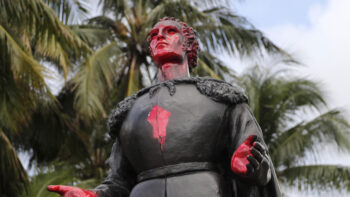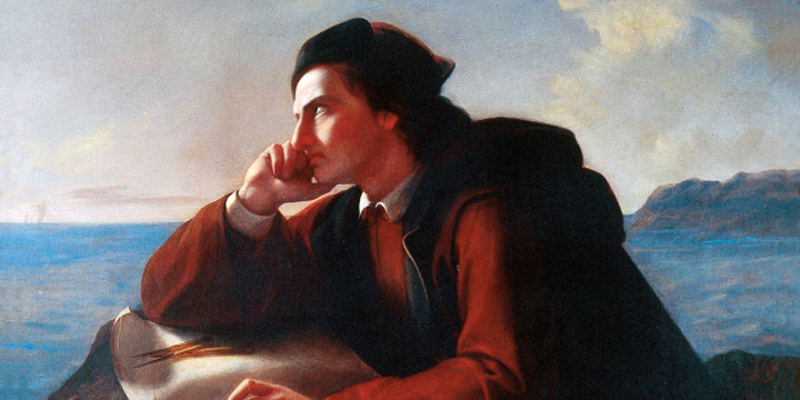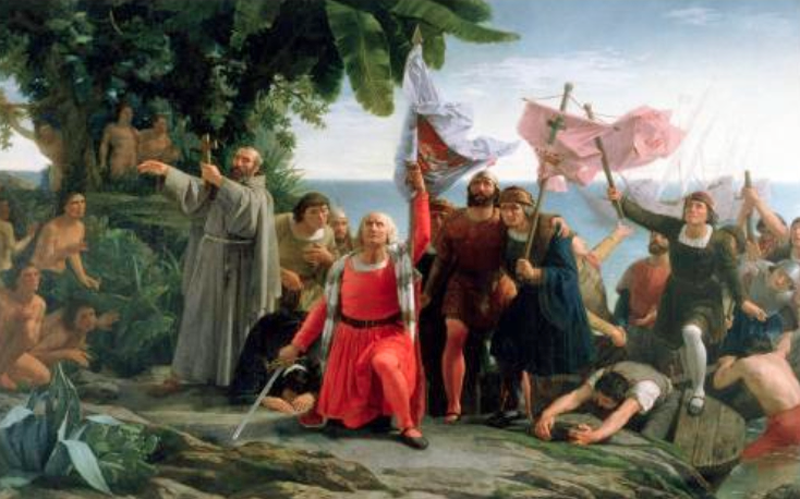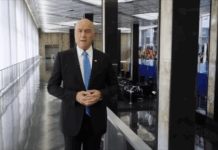By Mark Ellis —

Once regarded as a hero among Americans, his statues are now being toppled throughout the land and he’s derided as the instigator of genocidal policies that inflicted death on the native population of Hispaniola, the island he discovered – and by extension – into the Americas.
Yet this admittedly flawed human being also wrote in his journals of his passionate desire to serve Christ and carry the light of the Gospel to unreached people in the areas he found. He also saw himself playing a role in the fulfillment of prophecies related to the return of Christ.
“His own name, Christopher, which literally meant Christ-bearer, was to him a clear indication that God had called him to do this,” noted Peter Marshall and David Manuel, in their excellent book, The Light and the Glory. “He would quote in his journal such lines of Scripture as those in Isaiah, which meant so much to him:
‘Listen to me, O coastlands, and hearken, you peoples from afar. The Lord called me from the womb, from the body of my mother he named my name…I will give you as a light to the nations, that my salvation may reach to the end of the earth.’” (Isaiah 49:1,6)
Under the Pax Mongolica or Mongol peace, Europeans had enjoyed peaceful passage from Europe to Asia along the Silk Road. But after the Ottoman Turks captured Constantinople in 1453 establishing Sunni Islam as the state religion spread by jihad, the Silk Road became impossibly dangerous for Europeans to traverse.
As an alternative, Columbus was one of many seeking an ocean route to China, India and Japan, but only he was convinced he could travel west, by his calculations voyaging from the Canary Islands to Japan in only 2760 miles.
But when he sought funding for his expedition from the monarchs of Portugal, Spain, France and England his plan was roundly rejected as uncertain, mad, and “utterly impossible to any educated person.”
However, Columbus was convinced that Ferdinand and Isabella of Spain – because of their devotion to Christ – were the ones God chose to bring the Gospel to undiscovered lands. They had been preoccupied with wresting Islamic control over southern Spain from the Moors.

After the Spanish monarchs rejected his proposal in 1490, Columbus sought refuge and advice at the Franciscan monastery, La Rabida. He poured out his heart one night to the Queen’s confessor, Father Juan Perez, about his disappointments and dreams.
“On the following morning, Father Perez dispatched a messenger to the Queen, stating that he was convinced that God’s hand rested upon Christopher Columbus, and urging Her Majesty to reconsider his proposal,” Marshall noted.
In late 1491, Queen Isabella invited Columbus to join her in Santa Fe, outside the walls of Granada. When he arrived, the Moors were poised to surrender, and Columbus bore witness to the last Muslim foothold in Europe removed. The timing could not have been more fortuitous, because in the exhilaration of the moment, Ferdinand and Isabella finally agreed to his plan.

In preparing for his trip, Columbus noted that others had failed when they attempted to sail west from the Azores due to strong headwinds. But if he dropped below the Tropic of Cancer and headed west from the Canary Islands, he figured the wind would be at his back.
Columbus realized it should be possible to follow those winds to his destination, then head north and catch the prevailing winds back to Spain. “It was that simple, but no one had ever thought of it before,” Marshall noted.
Columbus regarded it as a revelation from God.
After his three ships departed the Canary Islands on September 8, 1492, they enjoyed smooth sailing for a time. At the start of each day the crew would sing:
Blessed be the light of the day
And the Holy Cross, we say;
And the Lord of Veritae,
And the Holy Trinity.
Blessed be th’ immortal soul,
And the Lord who keeps it whole,
Blessed be the light of day,
And He who sends the night away.
None of the crew had voyaged more than 300 miles offshore, and after traveling 3,000 miles westward, doubts and fears began to creep in. Some among the crew became mutinous, and the captains of the Pinta and the Nina called an emergency conference. After traveling 31 days, the captains vented to Columbus about the mood of their crews.
“If we continue one more day we’ll have a mutiny on our hands,” they told him.
Columbus reluctantly agreed that if they did not find land after three more days, they could turn around and go back. Undoubtedly, Columbus turned to prayer, praying as he had never prayed before.
Two days later, October 11th, with hope nearly gone, a shout went up from the crew. They spotted a reed and a piece of wood that seemed to have been shaped by a human being. Then they spotted a small branch with roses floating on top of the water.
The “Rose of Sharon” had listened to their prayers and brought an answer, the One who seldom answers early, but is never too late.
At 10 p.m. they saw a tiny light some distance ahead of them. After midnight, the electrifying cry from the Pinta went up, “Tierra! Tierra!” A lookout had spotted a small cliff, appearing in the moonlight as a silvery form along the water’s edge.
Columbus was the first to go ashore later that morning and christened the island San Salvador – “Holy Savior” — and prayed:
“O Lord, Almighty and everlasting God, by Thy Holy Word Thou has created the heaven, and the earth, and the sea; blessed and glorified be Thy Name, and praised be Thy Majesty, which hath deigned to use us, Thy humble servants, that Thy holy Name may be proclaimed in this second part of the earth.”

When Columbus encountered the natives of San Salvador, he was impressed by their healthy appearance “with no bellies on them” — nor any clothing. Columbus gave them gifts, “So that they might be well-disposed towards us, for I knew that they were a people to be delivered and converted to our holy faith rather by love than by force.”
Columbus had his men erect a large wooden cross on each island they explored, “as a token of Jesus Christ our Lord, and in honor of the Christian faith.”
They found the indigenous people peaceful and trusting, and Columbus gave firm orders that they should not be mistreated in any way.
The Santa Maria ran aground on Hispaniola after the crew fell asleep. But the disaster had a silver lining – or gold one – because the natives were in possession of masks of gold, gold bracelets, and other jewelry made from the precious metal. Columbus named the area La Navidad and decided to build a fort there, leaving 39 men behind.
He thought that when he sailed back to Europe and returned in a year’s time, the men would have discovered the mine supplying the gold, so that within three years Ferdinand and Isabella would have enough gold to equip a great expedition of crusaders to free the Holy Land from the Muslims.
“For I maintained to your Highnesses that all profits from this enterprise should be devoted to the conquest of Jerusalem, and your Highnesses smiled and said that such was your will, and that even without these gains, you had the same earnest desire.”
When Columbus returned to Europe in triumph and was ushered into the throne room of Ferdinand and Isabella, with marble columns bathed “in the light of a thousand candles, the court chroniclers record that his (Columbus’) deeply tanned complexion, gray hair, long nose, and noble bearing reminded them of a Roman senator.”
The two sovereigns “did something no one had ever seen them do before: they rose to meet him. And when he knelt to kiss their hands, they raised him up and ordered a chair brought for him—another unprecedented honor.”
Then Columbus opened a large chest filled with gold objects he had received trading with the natives, and Ferdinand and Isabella fell to their knees, lifted their faces toward heaven, and everyone sang the Te Deum:
We praise thee, O God : we acknowledge thee to be the Lord.
All the earth doth worship thee : the Father everlasting.
To thee all Angels cry aloud : the Heavens, and all the Powers therein.
To thee Cherubim and Seraphim : continually do cry,
Holy, Holy, Holy : Lord God of Hosts;
Heaven and earth are full of the Majesty : of thy glory…
On his second voyage to the New World, he took 17 ships with 1200 men, including farmers, priests and soldiers, but when they reached La Navidad, all the 39 left behind had been killed – “some by each other, most of them by tribes of Indians other than those they had befriended.”
It seems the 39 had been rapacious with the indigenous women, taking by force as many as they could. Instead of bartering for gold, they stole it. They began to quarrel among themselves, split into factions, and were apparently ambushed by other tribes.
Columbus’ high-minded ideas about spreading the light of the Gospel were undermined by wanton violence, the lusts of the flesh and the love of money. Worse, Columbus chose to turn a blind eye to the men’s excesses in these areas.
Many men in his new expeditionary party contracted a strange disease never seen before, syphilis, from the native women, which they introduced to Spain on their return home.
Everything began to go wrong, with their food supplies deteriorating rapidly in the tropical heat, and mosquito-borne diseases felling the strongest among them. Columbus mistakenly ordered each of the natives to pay an annual tribute of gold or be punished, but there were no mines or fields of gold to be found. The natives were also conscripted into forced labor – virtual slavery – working on their own land.
After 14 years of Spanish colonization, the indigenous population of Hispaniola fell from 300,000 to only 20,000, a sad and deeply tragic outcome.
On Columbus’ third voyage to the New World, things continued to go wrong. Rebellion had broken out among the colonists, with two armed camps on Hispaniola. Columbus mishandled the situation, word got back to Spain, so the sovereigns sent a trusted officer, Francisco de Bobadilla, to restore order.
When Bobadilla arrived, Columbus opposed him and the officer had Columbus and his brothers put in leg irons and sent home to stand trial. Ferdinand and Isabella were shocked to see their hero in chains when he returned in 1500.
The prophecies of Columbus
During these months at home, Columbus began to write a Book of Prophecies based on his understanding of the Scripture. His writings reflected certain beliefs – common at the time – about events that must unfold before Christ returned:
The Great Commission must be fulfilled, with the spread of the Gospel to every nation, making disciples, and baptizing them in the name of the Father, the Son, and the Holy Spirit.
Columbus believed the Garden of Eden would be rediscovered. When he first saw Venezuela in 1498, he thought Eden might be located in its mountains.
He argued that a final crusade would dislodge the Muslims from the Holy Land prior to the return of Jesus to Jerusalem.
He also wrote that a Last World Emperor would lead the crusade against the Muslims and greet Christ at Jerusalem once the previous steps were completed.
On the fourth voyage of Columbus, he explored Honduras, Nicaragua, and Costa Rica, where the indigenous people took him to gold fields with the metal easily obtained on the surface. When word got back to Europe, it sparked a gold rush by thousands of Conquistadors.
“Columbus had found his gold, but at what price! His health was ruined, his sanity nearly gone; two of his four ships would soon be too worm-eaten to go on, and he and his men would be stranded for months in the other two,” Marshall observed.
He began to build a settlement near the gold fields, but learned that a local tribe planned to attack them. Columbus and his men launched a preemptive strike and took a number of hostages, but in retaliation, several of his men were killed.
One night Columbus took refuge on his ship and fell into a deep sleep. Then something remarkable happened. God spoke to him through a dream. He heard a “compassionate voice” saying:
O fool and slow to believe and to serve thy God, the God of all! What more did He for Moses and for His servant David? Since you were born, He has always had you in his watchful care…The Indies, which are so rich in a part of the world, He gave you for yourself; you have divided them as it pleased you, and He enabled you to do this.
Of the barriers of the ocean sea, which were closed with such mighty chains, He gave you the keys… and (you) gained honorable fame.
Turn yourself to Him, and acknowledge your error; His mercy is infinite; your old age shall not prevent you from achieving great things.
You cry for uncertain help. Answer: who has afflicted you so greatly and so often? God or the world? The rewards and promises which He gives, He does not bring to nothing…nor does he inflict suffering in order to display His power. His deeds agree with His words; all that He promises He performs with interest…Fear not; have trust; all these tribulations are written upon marble and are not without cause.
Columbus awakened as if he had been in a trance. “I had no answer to give to words so true, but could only weep for my errors,” he noted in his journal.
By God’s grace, Columbus returned to Spain with what remained of his men after his fourth and final voyage of discovery.
In 1506, his health began to fail. “The tall proud old captain could no longer walk down to the harbor to see the bright sails in the morning sun…
“On Ascension Day, 1506, after receiving the Sacraments of the Church, Christopher Columbus said these words: ‘Father, into Thy hands I commend my spirit,’ and went to be forever with the Savior whose name he bore.”
Yes, Christopher Columbus was fallible; yes, he made mistakes, but God gave the keys to this “Christ-bearer” to remove the barrier of the ocean sea, once closed with mighty chains, to establish a beachhead for the Gospel in the Americas.
If you want to know more about a personal relationship with God, go here




The new standard is that unless people are perfect we tear down their statues. What about us? Are we perfect? It’s not a good standard to judge. All of our heroes were flawed. We are flawed. Their flaws don’t diminish the amazing things they did. We shouldn’t stop admiring them for Their defects. Conversely we shouldn’t hold them for saints. George Washington had slaves. So did Thomas Jefferson. Benjamin Franklin was profligate. Christopher Columbus let greed and ambition into his heart and didn’t restrain his men from doing evil to natives. Abraham Lincoln wanted to ship all the freed slaves to Belize, believing blacks and whites couldn’t get along. Martin Luther king jr is accused of womanizing. Does that cancel out everything good he did? But the heroes of the past are all better than the “heroes” that are inspiring our present generation of young idealists to topple statues. Karl Marx is responsible for the political philosophy that brought about the mass murder of tens of millions in Russia, in China, in Cambodia, in Africa, in Latin America. People ignore history . The only thing they have is the politics of hysteria. And so they riot, they vandalize, they demonize police, they tear down statues. We need to tear down sin and erect Jesus. (On the other hand, I personally cannot understand why statues were ever erected to confederate heroes since they stood for a system so evil that God poured out his wrath on America through the Civil War, a war that killed more Americans than any other war. I do not understand the use of the confederate flag either. Sorry just this California kid’s attempt to make sense of the world)
Comments are closed.